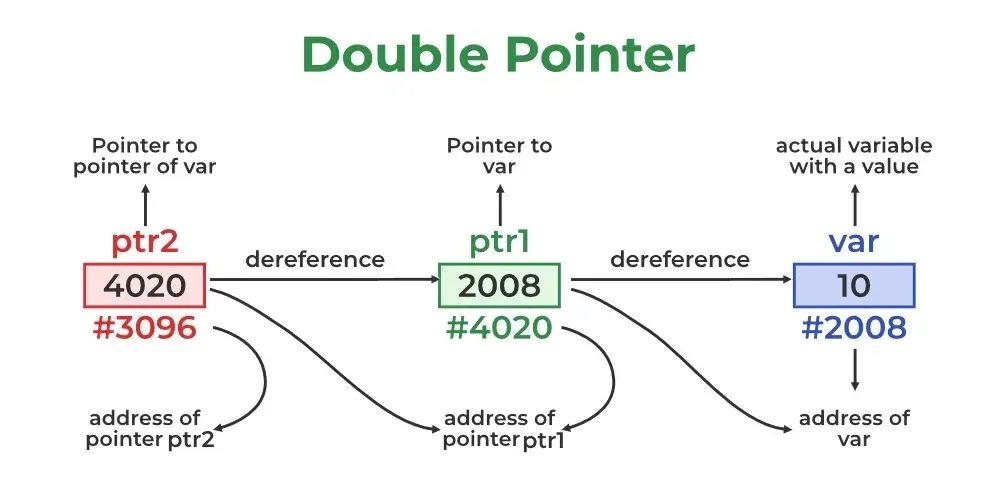C Pointer to Pointer (Double Pointer) (original) (raw)
Last Updated : 07 Mar, 2025
In C, **double pointers are those pointers which stores the address of another pointer. The first pointer is used to store the address of the variable, and the second pointer is used to store the address of the first pointer. That is why they are also known as a **pointer to pointer.
Let's take a look at an example:
C `
#include <stdio.h>
int main() {
// A variable
int var = 10;
// Pointer to int
int *ptr1 = &var;
// Pointer to pointer (double pointer)
int **ptr2 = &ptr1;
printf("var: %d\n", var);
printf("*ptr1: %d\n", *ptr1);
printf("**ptr2: %d", **ptr2);
return 0;}
`
Output
var: 10 *ptr1: 10 **ptr2: 10
**Explanation: In this code, **ptr1 is a pointer that stores the address of the integer variable **var. **ptr2 is a double pointer that stores the address of the pointer **ptr1. **ptr2 dereferences **ptr2 to get the value of **ptr1 (which is the address of **var) and then dereferences that address to get the value of **var itself.
Table of Content
- Syntax of Double Pointer
- Examples of Double Pointer
- Application of Double Pointers in C
- Multilevel Pointers in C
Syntax of Double Pointer
The syntax to use double pointer can be divided into three parts:
**Declaration
A double pointer can be declared similar to a single pointer. The difference is we have to place an additional ****'*'** before the name of the pointer.
**type **name;
Above is the declaration of the double pointer with some **name to the given **type.
**Initialization
The double pointer stores the address of another pointer to the same type.
**name = &single_ptr; // After declaration
**type **name = &single_ptr; // With declaration
**Deferencing
To access the value pointed by double pointer, we have to use the dereference operator * two times.
***name; // Gives you the address of the single pointer
****name; // Gives you the value of the variable it points to
The below image illustrates these for the first example:

In C, a double pointer behaves similarly to a normal pointer. So, the **size of the double-pointer variable is always equal to the normal pointers i.e. only depending on the operating system and CPU architecture.
- **8 bytes for a **64-bit System
- **4 bytes for a 32-bit System
**Examples of Double Pointer
The below examples demonstrate the use of double pointers for different applications in C:
Find the Size of Double Pointer
C `
#include <stdio.h>
int main() {
// Defining single and double pointers
int a = 5;
int* ptr = &a;
int** d_ptr = &ptr;
// Size of double pointer
printf("%d bytes", sizeof(d_ptr));
return 0;}
`
**Note: The output of the above code also depends on the type of machine which is being used.
Create a Dynamic 2D Array
C `
#include <stdio.h> #include <stdlib.h>
int main() { int m = 2, n = 3;
// Create a double pointer
int** arr;
// Allocate memory for rows
arr = (int**)malloc(m * sizeof(int*));
// Allocate memory for each row
for (int i = 0; i < m; i++)
arr[i] = (int*)malloc(n * sizeof(int));
// Initialize with some values
for (int i = 0; i < m; i++) {
for (int j = 0; j < n; j++) {
arr[i][j] = i * n + j + 1;
}
}
// Print the array
for (int i = 0; i < m; i++) {
for (int j = 0; j < n; j++) {
printf("%d ", arr[i][j]);
}
printf("\n");
}
// Free allocated memory
for (int i = 0; i < m; i++) {
free(arr[i]);
}
free(arr);
return 0;}
`
**Explanation: A 2D array is an array where each element is essentially a 1D array. This can be implemented using double pointers. The double pointer points to the first element of the 2D array, and each pointer it references points to a dynamically allocated 1D array using malloc().
Pass Array of Strings to Function
C `
#include <stdio.h>
// Function that takes array of strings as argument void print(char** arr, int n) { for (int i = 0; i < n; i++) printf("%s\n", *(arr + i)); }
int main() { char* arr[10] = {"Geek", "Geeks", "Geekfor"}; print(arr, 3); return 0; }
`
**Explanation: Array of strings are generally stored as array of pointer to strings. This can be passed using double pointers to function.
Application of Double Pointers in C
Following are the main uses of pointer to pointers in C:
- They are used in the dynamic memory allocation of multidimensional arrays.
- They can be used to store multilevel data such as the text document paragraph, sentences, and word semantics.
- They are used in data structures to directly manipulate the address of the nodes without copying.
- They can be used as function arguments to manipulate the address stored in the local pointer.
Multilevel Pointers in C
Double Pointers are not the only multilevel pointers supported by the C language. What if we want to change the value of a double pointer? In this case, we can use a triple pointer, which will be a pointer to a pointer to a pointer i.e, int ***t_ptr.
Examples
int*** ptr3; // Triple pointer
int**** ptr4; // Quadruple Pointer
Similarly, to change the value of a triple pointer we can use a pointer to a pointer to a pointer to a pointer (Four level Pointer). In other words, we can say that to change the value of a " level - x " variable we can use a " level - x+1 " pointer. And this concept can be extended further.
**Note: We can use any level pointer in C. There is no restriction about it but it makes the program very complex and vulnerable to errors.